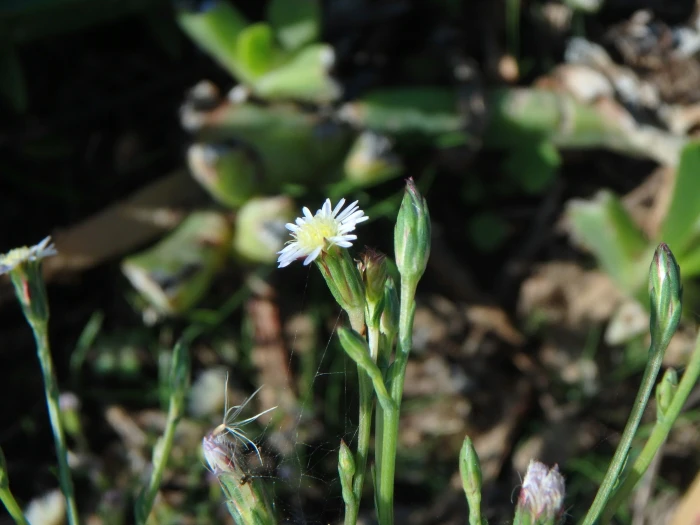Eastern Annual Saltmarsh Aster
(Symphyotrichum squamatum)
Eastern Annual Saltmarsh Aster (Symphyotrichum squamatum)
/
/

Daniel Cahen
CC BY 4.0
Image By:
Daniel Cahen
Recorded By:
Copyright:
CC BY 4.0
Copyright Notice:
Photo by: Daniel Cahen | License Type: CC BY 4.0 | License URL: http://creativecommons.org/licenses/by/4.0/ | Rights Holder: Daniel Cahen | Publisher: iNaturalist | Date Created: 2018-11-27T08:31:16-08:00 |






















Estimated Native Range
Climate Requirements
| • Precipitation | 0" - 101" |
| • High Temp. | 58°F - 102°F |
| • Low Temp. | 11°F - 68°F |
Summary
Symphyotrichum squamatum, commonly known as Eastern Annual Saltmarsh Aster, is an annual herb native to coastal salt marshes, brackish wetlands, and tidal shores in South America. It is also found in other tropical areas of the world. This plant typically reaches up to 3 feet in height and has a slender, erect form. The leaves are thin, hairless, and green, often with a lanceolate shape. Symphyotrichum squamatum blooms from late summer to fall, producing a raceme inflorescence with heads that open into bright yellow disc florets surrounded by ray florets that can vary in color from white to lavender. The flowers are moderately showy and attract a variety of pollinators, including butterflies and native bees.
The Eastern Annual Saltmarsh Aster is valued for its wildlife benefits, particularly as a nectar source for pollinators. It is suitable for naturalistic plantings in wetland restoration projects, rain gardens, and as part of native plant gardens where its tolerance for saline conditions can be utilized. It thrives in full sun to part shade and prefers moist to wet soils with good drainage. While it is not commonly used in traditional garden settings, its adaptability to challenging wet and salty environments makes it a useful species for specific ecological niches. Potential problems include susceptibility to rust and mildew in overly humid conditions. It is not known to be invasive when grown outside its native range, but as with all native plants, care should be taken to ensure it does not spread into natural areas where it is not originally found.CC BY-SA 4.0
The Eastern Annual Saltmarsh Aster is valued for its wildlife benefits, particularly as a nectar source for pollinators. It is suitable for naturalistic plantings in wetland restoration projects, rain gardens, and as part of native plant gardens where its tolerance for saline conditions can be utilized. It thrives in full sun to part shade and prefers moist to wet soils with good drainage. While it is not commonly used in traditional garden settings, its adaptability to challenging wet and salty environments makes it a useful species for specific ecological niches. Potential problems include susceptibility to rust and mildew in overly humid conditions. It is not known to be invasive when grown outside its native range, but as with all native plants, care should be taken to ensure it does not spread into natural areas where it is not originally found.CC BY-SA 4.0
Plant Description
- Plant Type:
- Height: 1-3 feet
- Width: 1-2 feet
- Growth Rate: Moderate
- Flower Color: White, Yellow
- Flowering Season: Summer, Fall
- Leaf Retention: Deciduous
Growth Requirements
- Sun: Full Sun, Part Shade
- Water: Medium
- Drainage: Medium
Common Uses
Bee Garden, Border Plant, Butterfly Garden, Low Maintenance
Natural Habitat
Native to coastal salt marshes, brackish wetlands, and tidal shores
Other Names
Common Names: Scaleleaf Aster , Bushy Starwort , Squammy Aster
Scientific Names: Symphyotrichum squamatum , Aster asteroides , Aster bangii , Aster barcinonensis , Aster divaricatus , Aster divaricatus var. sandwicensis , Aster divaricatus var. sandwicensis , Aster linifolius , Aster moelleri , Aster pseudobarcincnensis
GBIF Accepted Name: Symphyotrichum squamatum